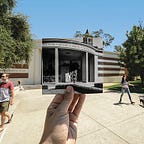What do an Arcadia mansion, a frontier painter, medieval elves and a reluctant cat have to do with the Fisher Museum?
The Story of the Jinks Room Murals
The House and Its Murals
In 1912 Anita Baldwin McClaughry, daughter of California pioneer tycoon (and ubiquitous Los Angeles area namesake) Elias Jackson “Lucky” Baldwin, began construction on her massive Anoakia estate in Arcadia, Califonia. The palatial mansion was completed in 1914 and included a series of murals by painter Maynard Dixon. McClaughry had purchased two early works from the then-unknown Dixon and liked them so much she commission the murals to be installed in her home. Dixon worked with the mansion’s architect, Arthur B. Benton, and was paid $10,000 for the work.
The first set of murals, depicting scenes in the lives of the Plains Indians, were firmly in Dixon’s wheelhouse. The artist, who began his career as a magazine illustrator, had already painted scenes of the American West for a rail depot in Arizona in 1907. The Plains Indians of Anoakia were rendered in exactly the style Dixon would soon become famous for.
The second mural created for McClaughry was decidedly NOT a frontier landscape with iconic western figures. Instead the so-called Jinks Room murals depicted a seemingly English country scene of medieval merriment and hijinks. The Jinks Room was long assumed to have been a children’s playroom but research by USC art history students in 2010 instead revealed that the room served as a venue for McClaughry’s entertaining of LA society (appropriate given the revelry depicted). The mural panels were installed within and between the doors and pilasters of the room, each 55 inches tall and varying in length from 17 inches to 13 feet.
This commission would be life-changing for Dixon, a fact which he himself acknowledged:
“ My return from New York … marked the beginning of my real development. I was getting a new direction rather than a new manner and beginning to find myself. And it was Anita Baldwin who gave me my first chance in that new direction. Her encouragement of my ideals, and her purchased of two of my easel paintings, followed by the order for mural paintings to be done as I wanted to do them, gave me the start… As a painter, then, I date from 1912.”
Anita Baldwin McClaughry died in 1939 and Dixon in 1946. Following McClaughry’s death the mansion became Anoakia School for Girls, and later a coeducational school. Dixon’s widow, the painter Edith Hamlin, occasionally traveled from her home in the Bay Area to touch up the murals but for the most part in the second half of the 20th century they were virtually ignored. The school vacated the home in 1990 and the structure remained vacant for a decade.
Removal and Restoration
In 1998 with plans to demolish the mansion and its surrounding estate for a new housing development, the owners, the McCaslin family, decided to first remove and donate the murals. The Plains Indians went to the California State Library in Sacramento (pictured above) while the largest six of the nine Jinks Room murals were gifted to the Fisher Gallery, today the Fisher Museum of Art at USC.
Rendered with oil paints on a heavy fabric, the murals were originally adhered to plaster on the brick and cinder block walls of the room with an adhesive of lead white and linseed oil — a method that dates to 17th century Europe. The lead is naturally biotoxic which long helped to protect the work from insects and biodeterioration. The adhesive process was extremely strong and stable which maintained the mural in place for the 80+ years they were installed at Anoakia. But the same strong adhesive posed a challenge for removal. A conservation team, ConservArt Associates, was contracted to carefully remove and restore the murals. After testing various methods, the conservators detached the murals using a pneumatic chisel between the plaster layer and the brick or cinder block walls. While some paint loss occurred, this method proved to be the least damaging means of removal.
After detachment and transport to the conservators workshop, the murals were adhered to new aluminum panels honoring the original and often irregular shape of each, due to the architectural features of the room (as seen in the images above). The murals were then cleaned of old varnish, graffiti (damn school children!) and dust. The paint losses were filled in with a putty to mimic the texture of the surrounding paint and then inpainted with conservation grade revesible paints. Finally the works were lightly varnished.
Jinks Room Mural at USC
In the fall of 2000, the murals were first displayed at the Fisher Gallery as part of the exhibition entitled USC Collects California. They remained on view in Quinn Wing through the end of 2001. Placed into storage for a time, the murals have been on display since 2011 in the Ronald Tutor Campus Center (TCC). On permanent loan through the Fisher Museum of Art @ the Campus Center partnership, the beautiful and playful murals can be viewed in the hallway next to the TCC Ballroom on the lower level.
Go check them out!
Sources:
The Artist and His Model: The Crossing Paths of Maynard Dixon and George Whitewing by Barbara Winther, Western Historical Quarterly, Autumn 2018.
“Dixon Mural Conservation Summary” by ConservArt Associates, Jinks Room Mural files, USC Fisher Museum of Art
“Appraisal Report of Jinks Room Murals” by Metropolitan Fine Arts Associates, Jinks Room Mural files, USC Fisher Museum of Art
